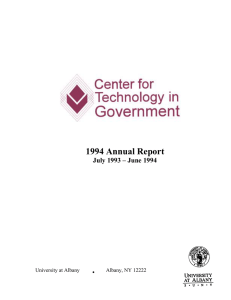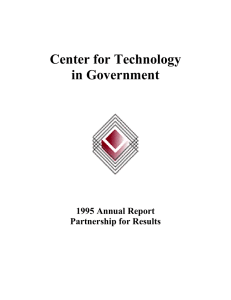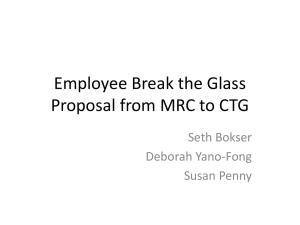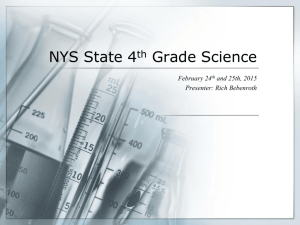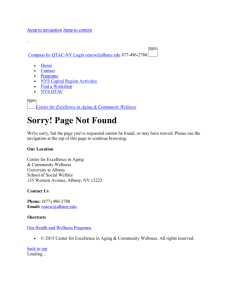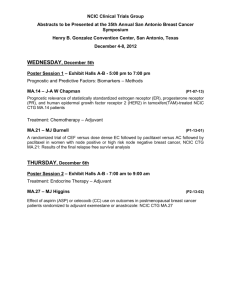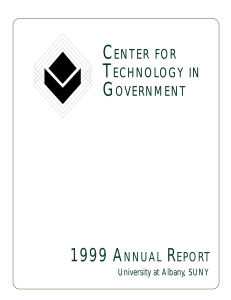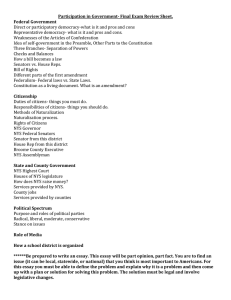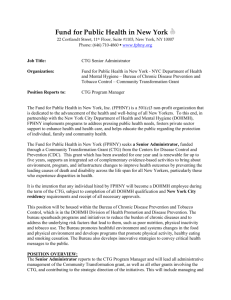Center for Technology in Government 1997 Annual Report
advertisement
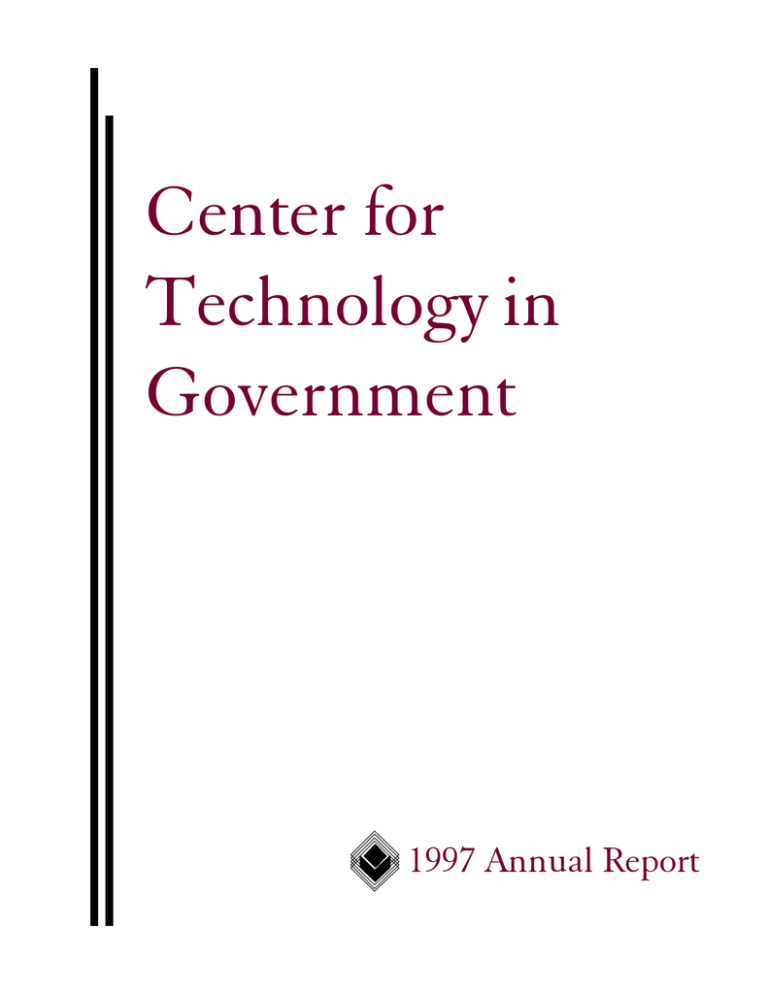
C ENTER FOR TECHNOLOGY IN GOVERNMENT Center for Technology in Government 1997 Annual Report 1997 A NNUAL R EPORT Center for Technology in Government 1997 Annual Report July 1996 - June 1997 C ENTER FOR TECHNOLOGY IN GOVERNMENT The Center for Technology in Government pursues new ways of applying computing and communications technologies to the practical problems of information management and service delivery in the public sector. The Center's program seeks to reduce the costs and improve the quality of government services, reduce the risks of innovation, and share the results of its projects throughout the public sector. 1997 A NNUAL R EPORT July 1997 Dear Friends, The past year has been filled with opportunities to learn about, use, and evaluate the information tools of our increasingly global society. Our projects this year concentrated on the potential of the World Wide Web to deliver government services to citizens. Our publications and information dissemination activities became increasingly electronic ones as the number of reports and handbooks readers download from our Web site has begun to exceed the number we distribute in printed form. As we investigated the Internet in the research portion of our projects, we found ourselves using its powerful communications and presentation features in our daily work. Its already hard to remember how we managed without it. The rich and complex network of computers represented by the Internet, has been mirrored in our project partnerships as the number and variety of government, corporate, and university partners continue to grow. The Internet Testbeds alone benefitted from the contributions of professionals representing twelve public agencies, twelve private companies, and five academic institutions. We welcomed two new corporate partners this year, including Bluestone, Inc. and NYSERNet. SUNY at Plattsburgh and Empire State College are our newest academic partners. Among the government agencies involved in CTG work, all listed inside, we owe special thanks to the New York State Governors Task Force on Information Resource Management, the State Archives and Records Administration, and the New York State Forum for Information Resource Management for steady involvement and invaluable support. The continued enthusiastic encouragement of University at Albany President Karen Hitchcock and Vice Presidents Jeanne Gullahorn and Carl Carlucci has given us the confidence and resources to try new approaches to applied research that bring the University more actively into the communities we serve. Thanks to their help, we also have a new home. Our new offices, lab, and seminar room designed specifically for the work we do enhance all of our programs. Finally, the continuing benefits of our Innovations in American Government Award have allowed our excellent staff, fellows, and students to reach new audiences in new ways, to share the results of our work, and to learn from others across New York State, throughout the US, and around the globe. Sincerely, Sharon S. Dawes, Director C ENTER FOR TECHNOLOGY IN GOVERNMENT Delivering on the World Wide Web: Government is all about information and service delivery. The World Wide Web, offering virtually unlimited access and almost instant feedback, seems perfectly suited for government work. By transcending time, place, and distance, the Web removes barriers that often hamper effective service. For these reasons, most government organizations are eager to use the Web to deliver services to citizens and to conduct internal business. However, the Web abounds with examples of premature, ineffective attempts to take advantage of its power to visualize and communicate information. Developing a service delivery strategy that incorporates the World Wide Web is neither simple, straightforward, nor inexpensive. The New York State Internet Testbeds improved the ability of government agencies to deliver services on the Web in two ways: through the development and evaluation of prototype Web sites for six state agencies and one local government and through a technical feasibility study about how the Web can become a universal interface between government and the public. The Internet Services Testbed explored the organizational resources, processes, policies, and technologies that agencies need in order to develop and deliver specific information-based public services over the WWW. The Internet Technologies Testbed tested the feasibility of using the Web as a universal interface for delivery of government services within four service areas: information dissemination, business applications, group collaboration, and education and training. Together, the testbeds produced a set of practical tools (available in print and on the CTG Web site - http://www.ctg.albany.edu) to assist any public organization in its effort to provide Web-based services: Ø World Wide Web Starter Kit for Web novices Ø Handbook of recommended practices called Designing and Delivering Government Services on the WWW Ø Cost/Performance model for assessing WWW service investments Ø Online Internet Security Seminar Ø Online assessments of the technologies that make it possible to consider The World Wide Web as a Universal Interface to Government Services 2 1997 A NNUAL R EPORT The Internet Testbeds These products have been distributed to all NYS government agencies, to all 50 states, to hundreds of local governments, and via our WWW site, to thousands of other users around the world. By leveraging the work of corporate, academic, and government partners, the Testbeds were a cost-effective, comprehensive way to create tools and practices that apply to any government agency. They reduce the learning curve, help agencies avoid costly mistakes, and encourage the use of a tested, consistent approach to Web-based government services. Internet Technologies Testbed Partners Government NYS Forum for Information Resource Management State University of NY System Administration Corporate Bluestone, Inc. Deloitte & Touche/DRT Systems EMI Communications Corp. Microsoft Corp. NYNEX NYSERNet, Inc. Silicon Graphics Academic Empire State College State University of NY at Plattsburgh University at Albany/SUNY Internet Services Testbed Partners Government Empire State Development Hamilton County NYS Archives and Records Administration NYS Department of Health NYS Department of Transportation NYS Division of Housing and Community Renewal NYS Division of Military and Naval Affairs NYS Forum for Information Resource Management NYS Governors Traffic Safety Committee NYS Office of Alcoholism & Substance Abuse Services NYS Office of Real Property Services 3 Corporate AT&T Microsoft Corp. Digital Equipment Corp. Silicon Graphics EMI Communications SUN Microsystems Eric Elgar Unified Technologies Academic Hudson Valley Community College University at Albany/SUNY C ENTER FOR TECHNOLOGY IN GOVERNMENT Works in Progress Models for Action Government agencies create electronic records in a myriad of forms and formats but often lack adequate tools to manage them. As a result, many agencies are in danger of losing access to records stored in personal computers, e-mail boxes, or personal network directories. Others face the problem of linking documents created in different forms and formats to business transactions and therefore find that their electronic records do not meet their organizations evidentiary needs. The permit issuance process of the NYS Adirondack Park Agency (APA), a project partner, is a case in point. APA may need to access a paper file folder, e-mail messages, word-processing files, and electronic maps in order to compile a complete record of a permit transaction. Models for Action, funded in part by a $140,000 two-year grant from the National Historical Publications and Records Commission, integrates practical and theoretical work in electronic records management, network-based system development methodologies, and business process improvement practices. Its goal is to develop and test a practical tool that addresses electronic records management requirements during the process improvement and system design phases of system development. The tool will help agencies identify the technology, policy, and management factors that lead to records that support agency operations, secondary uses, evidentiary needs, and archival purposes. The project will conclude in the winter of 1998. Best Practices in State-Local Information Systems The complexity of many agencies working across two levels of government makes state-local information system initiatives very difficult and error-prone. A massive amount of information exchange occurs between state and local governments, but few systems effectively integrate service goals, business processes, and technologies across both state and local participants. This project is designed to identify a set of recommended practices to guide future intergovernmental systems initiatives to success. The Governors Task Force on IRM Subcommittee on Local Government established a framework for the effort by creating a Special Work Group on Intergovernmental Information Systems. The work group developed a set of characteristics that exemplify ideal intergovernmental information systems projects and barriers to achieving them. These ideals and barriers shaped the investigation of eleven existing projects involving 150 state and local officials. The main project deliverable, a handbook of principles and practices that lead to successful state-local systems, will be distributed in the fall of 1997. 4 1997 A NNUAL R EPORT Looking Ahead In the coming year, we expect to conduct three major projects. One will look at the information sharing requirements of the states most expensive human service program, another will initiate a multi-year investigation into government data management issues. A third will involve CTG in a nationwide research alliance. Information Sharing in Medicaid Managed Care, sponsored by the Governors Task Force on IRM, will support New Yorks shift from fee-for-service to managed health care for most Medicaid eligibles. The project team, involving both public and private organizations, will investigate the policy, management, and technology factors associated with key information exchange requirements. The Data Management Testbeds will explore a series of agency-proposed projects that look at ways to collect, organize, access, analyze, and use government information. We expect to be involved in projects that use data modelling, data warehousing, decision support systems, electronic records systems and others to explore ways to meet the information needs of policy makers, program managers, front line workers, researchers, and citizens. The National Computational Science Alliance is a major new program sponsored by the National Science Foundation and organized by the University of Illinois at Urbana-Champaign. As the lead government outreach partner, CTG will work with researchers around the country who are engaged in the development and application of advanced computing tools for science, business, education, and government. 5 C ENTER FOR TECHNOLOGY IN GOVERNMENT Partners Our program operates on a partnership model that allows us to tackle many different kinds of projects by putting together time-limited partnership teams that represent the elements and expertise needed for success. The CTG professional staff act as project managers and specialize in such activities as group facilitation, decision support, process analysis, current practices research, and interorganizational communications. This allows each government, corporate, and academic partner to concentrate on the areas that need specialized programmatic, technical, or analytical expertise. Government Each Center project involves a partnership with experienced public managers working on innovative applications of technology to improve public services and government operations. Our government partners exemplify the critical combination of policy, management, and technology factors that shape every project. During the past year, more than two dozen state and local agencies were project partners and scores more participated in surveys, interviews, or some other aspect of project activities. Corporate Private corporations bring state-of-the-art information technologies and services. Since these companies have both business and government customers, they offer a broader context for problemsolving than either sector can achieve on its own. Nine of our more than forty corporate partners were active this year either supporting specific projects or helping to equip and manage our Government Technology Solutions Laboratory. Academic The University community offers a multidisciplinary research faculty and graduate education programs which attract talented students from around the world. At CTG, they contribute the perspectives of information science, public affairs, business management, computer science, education, and others. Faculty, staff, and students from four academic institutions participated in this years projects. 6 1997 A NNUAL R EPORT Resources Partnerships generate a synergy of ideas and tangible resources that leverage New York States investment in the Center. This year our annual appropriation was augmented by corporate in-kind contributions valued at $235,000, agency staff efforts worth $114,000, $22,000 from sales and contracts, and $97,000 in support from academic partners and our home campus, the University at Albany. In addition, the multi-year Innovations and Models for Action grants continued to provide funding for specific projects and outreach efforts. Total Value of 1997 Resources July 1996 - June 1997 Total Value of Resources State appropriation Corporate in-kind contributions Agency in-kind contributions University contributions Sales and contracts $ 1,234,583 766,800 234,915 113,727 96,941 22,200 New corporate contributions this year allowed our Internet Testbeds to take advantage of the very latest tools in the market (and some not quite on the market). They also augmented our permanent laboratory, built with $2.5 million in new and past corporate contributions of equipment, software, and services. In-kind Corporate C ontrib utions for 1996-97 Partner Purp ose Am ount Bluestone, Inc. Internet T echnologies Testbed $ 3,800 D eloitte & Touche (DRT System s) Internet T echnologies Testbed 81,871 EM I Com m unications Internet T echnologies & Services T estbeds H ewlett Packard Laboratory Infrastructure 11,000 Laboratory Infrastructure 13,576 M icrosoft Corporation 1,400 Internet T echnologies & Services T estbeds N YN EX Internet T echnologies Testbed 2,500 N YS ERNet Internet T echnologies Testbed 1,300 Silicon Graphics Com puter System s Internet T echnologies & Services T estbeds 5,000 SU N M icrosystem s Internet Services T estbed T otal for 96-97 112,868 $ 233,315 7 C ENTER FOR TECHNOLOGY IN GOVERNMENT Technology and Knowledge Transfer Knowledge building is a major portion of the Centers mission. We actively disseminate the results of every project through public demonstrations, project reports, conference presentations, and practical tools that can help government organizations anywhere take advantage of the work of each project team. In the past year, we have seen explosive growth in use of our World Wide Web site where every project is described and all products are made available to any interested user. The site receives nearly 140 visitors each day, with notable spikes in activity each time we announce new products or results. We are particularly proud of Making Smart IT Choices, a handbook of our methodology for assessing problems, choosing technology tools, and evaluating the results. Smart IT was made possible by the Ford Foundation grant that accompanied our 1995 Innovations in American Government Award. This two-year grant continues to provide essential funding for special publications and events aimed at information dissemination and replication of our program. These efforts include our quarterly newsletter, Innovations, our new program brochure, and an upcoming international research workshop devoted to better linkages between academic research and the practice of public information management. 8 1997 A NNUAL R EPORT Although we continue to distribute all reports and handbooks in printed form, our most popular publications tend to be downloaded in much greater numbers than the print versions one more bit of evidence that the electronic information age is upon us. Key print and electronic publications released this year include: Ø Ø Ø Ø Ø Ø Ø Online World Wide Web Starter Kit Developing and Delivering Government Services on the World Wide Web: Recommended Practices for NYS Online Internet Security Seminar Delivering on the Web: the NYS Internet Services Testbed Online Cost Estimation Spreadsheet for Web Services The World Wide Web as a Universal Interface to Government Services Making Smart IT Choices In addition, our work has been covered in Governing, The Public Innovator, Civic.com, Government Technology, Government Computer News, American City and County, Capital District Business Review, The Schenectady Daily Gazette, and Electronic Government International. Of special note is our first case of technology transfer: our prototype NYS Spatial Data Clearinghouse (a 1995-96 project) has become the foundation of the newly implemented New York State GIS Clearinghouse a government-wide information resource sponsored by the Governors Task Force on IRM and operated by the New York State Library for federal, state, local, and private users. 9 C ENTER FOR TECHNOLOGY IN GOVERNMENT CTG International The concept of a global society became a reality for CTG this year. Our first international experience working with the Government of Lebanon in 1996 led to a series of international activities this year that has greatly enriched our understanding of public sector information issues and opportunities and identified new colleagues and research partners around the world. A sampler: Korean Partnership The National Computerization Agency of the Republic of South Korea entered into a three-year partnership agreement with the University to train selected professional staff in one-semester residencies here at Albany. Rockefeller College of Public Affairs & Policy, the NYS Forum for Information Resource Management, and CTG are all members of the Partnership. The first cadre of Korean professionals arrived in January 1997 and CTG was honored to host Mr. Jung Sub Lee as an intern with our State-Local Best Practices Project. Egyptian Parliament Our association with the Universitys Center for Legislative Development, begun in the Lebanon project, continued with opportunities to present and discuss information policy and management strategies with staff of the Egyptian Peoples Assembly. Italian Government Study Tour Italys Istituto RSO, an operations research organization, led a US study tour for Italian government officials in April 1997. CTG conducted a full day briefing including discussions with our agency partners in the NYS Department of Motor Vehicles and NYS Office of Alcoholism and Substance Abuse Services about how their projects at CTG affected their later program performance. Netherlands Informatization Project Researchers from Tilburg University in the Netherlands made two trips to CTG this year to discuss our mutual interest in the effect of information technology, especially telecommunications, on both government and society. The Tilburg program on Law and Informatization, including research sponsored by the Dutch government, shares our interest in understanding the interaction of governance, management, and technology. German Parliamentary Commission on the Information Society Professor Herbert Kubicek from the University of Bremen visited CTG as part of an American study tour sponsored by a Commission of the German Parliament to map Germanys Road to the Information Society. His visit to CTG was part of a review of models of new institutions designed to support better understanding of information-driven societal change. United States Visitors and Outreach Officials from South Carolina visited CTG to learn about our program and its prospects for replication. A program director from the University of Michigan made a similar visit. CTG was also featured as a current practice model for other governments at the Kennedy Schools Strategic Computing program. 10 1997 A NNUAL R EPORT Staff Achievements The Center for Technology in Government is fortunate to have a talented and dedicated staff of professionals, faculty fellows, and students who contribute to every project, program, and publication. During the past year, a number of them have achieved personal and professional goals, and built individual records of excellence and scholarship while carrying out demanding CTG assignments. Grants and Awards Ø Ann DiCaterino: Graduate Academic Achievement Award, School of Business, University at Albany Ø Kristine Kelly: UAlbany Graduate Student Association Grant for travel to present two research papers at the Mini-Euro Conference on Operations Research Ø Claire McInerney: Grant from the Council on Library Resources to support dissertation research on the information needs of telecommuters Degrees Ø Ann DiCaterino: Master of Business Administration, University at Albany Ø Darryl Green: Master of Arts in Organizational Communications, University at Albany Publications Ø Sharon Dawes: Interagency Information Sharing: Expected Benefits, Manageable Risks, Journal of Policy Analysis and Management Ø Kristine Kelly: Models for Action: Developing Practical Approaches to Electronic Records Management and Preservation, Bulletin of the American Society for Information Science, coauthored with Alan Kowlowitz, NYS Archives and Records Administration Ø Claire McInerney and David Connelly: Forward Planning is the Best Policy, Electronic Government International Ø Theresa Pardo: Web Aids Business, Service Delivery, American City and County Special Assignments Ø Peter Bloniarz: Consulting with the United Nations in Belarus Ø Anthony Cresswell: Project Director (jointly with Harvard Institute for International Development) for MIS planning in Malaysia, and consulting for the US Agency for International Development in Panama and Cambodia. Ø Sharon Dawes: Advisory Board member, University of Michigan School of Information, and Guest Faculty at the Annual Archival Institute at the University of Pittsburgh Ø Kristine Kelly: Consulting with Harvard Institute for International Development in Malaysia 11 C ENTER FOR TECHNOLOGY IN GOVERNMENT Year in Review August 1996 The New York State Spatial Data Clearinghouse was honored as the best intergovernmental application for 1996 and received one of nine NASIRE awards. NASIRE, the National Association of State Information Resource Executives, gives the annual awards for achievement in information technology. September 1996 CTG hosted an information and demonstration booth at the Government Technology Conference in Albany. Prototype demos, reports and information packets were provided to visitors who attended the annual three day event. CTG staff also conducted a preconference tutorial entitled Making Smart IT Choices. October 1996 Nearly 1,000 copies of Designing and Delivering Government Services on the World Wide Web: Recommended Practices for New York State were distributed around the country in the initial dissemination. This useful tool has been downloaded from the CTG Web site nearly 1500 times and is also available in paper form. Best Practices in State and Local Information Systems project was initiated by CTG and the Governors Task Force on IRM. November 1996 Universal Interface Demo Day was held in the University at Albanys Campus Center Ballroom. The half day program was attended by more than 200 people representing 28 NYS agencies, seven local governments, three academic institutions, and representatives from nine private sector companies. Researchers from Tilburg University in the Netherlands visited CTG on their US study tour. 12 1997 A NNUAL R EPORT Nearly 900 copies of Making Smart IT Choices were distributed in the initial dissemination of this CTG handbook for assessing problems and devising IT solutions. January 1997 World Wide Web as a Universal Interface to Government Services was distributed in print form to about 800 individuals. The online version, containing hundreds of links to sites on the WWW, also contains a search engine and other navigation aides. The first Korean partnership participants arrived in Albany to begin their studies and internships. February 1997 Delivering on the Web: Internet Services Testbed Project Report describing the barriers and lessons of WWW services was distributed to more than 1,000 people. April 1997 The CTG office and laboratory moved off the main University at Albany Campus to a newly renovated small office building about a mile away. Current and even some former staff spent several days packing, unpacking, plugging in, powering up, and setting up the new space. Our new neighbors at the Center for Stress and Anxiety Disorders, have been very helpful during our transition. While some of us miss the main campus, we all appreciate the windows. CTG hosted several groups of visitors in our new offices. South Carolina officials spent a day with us talking about the possibility of replicating CTG in their state. Twenty-two Italian researchers and government officials also spent a day learning about CTGs mission and projects. We also met with a representative of the German Parliamentary Commission on the Information Society. 13 C ENTER FOR TECHNOLOGY IN GOVERNMENT Center for Technology in Government Director Sharon Dawes Team Leaders Peter Bloniarz, Research and Laboratory Director Sally Goodall, Operations Theresa Pardo, Projects Professional Staff Donna Berlin, Internet Coordinator Ann DiCaterino, Project Support Manager Winsome Foderingham, Education Coordinator Darryl Green, Project Support Manager Linda Keane, Secretary Kristine Kelly, Research Associate Claire McInerney, Information Coordinator Derek Werthmuller, Systems Administrator Research & Faculty Fellows David Andersen, Public Administration & Policy and Information Science Anthony Cresswell, Educational Administration & Policy and Information Science John Rohrbaugh, Public Administration & Policy Sandor Schuman, Public Administration & Policy Graduate Assistants David Connelly, Public Administration & Policy David Filbert, Political Science Christian Harris, Computer Science Kai Larsen, Information Science Mei-Huei Tang, Computer Science Wen-Li Wang, Computer Science Jihong Zeng, Information Science Student Assistants Monica Estrada, Criminal Justice & Political Science Mballou Kaba, Business Kameela Faircloth, Biology Sara Kline, English Sean Mornan, Political Science Unza Shipman, English Peter Wilson, Political Science Dawn Zicholtz, Psychology Funding for the production of this Annual Report was provided in part by the Ford Foundation 1997 A NNUAL R EPORT CENTER FOR TECHNOLOGY IN GOVERNMENT UNIVERSITY AT A LBANY, SUNY 1535 WESTERN AVENUE ALBANY, NY 12203 PHONE: (518) 442-3892 FAX: (518) 442-3886 e-mail: info@ctg.albany.edu http://www.ctg.albany.edu


